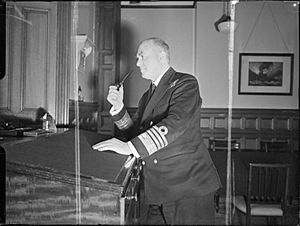Charles Kennedy-Purvis facts for kids
Quick facts for kids
Sir Charles Kennedy-Purvis
|
|
|---|---|

Admiral Kennedy-Purvis as Deputy First Sea Lord during World War II
|
|
| Nickname(s) | K-P |
| Born | 2 May 1884 |
| Died | 26 May 1946 (aged 62) |
| Allegiance | |
| Service/ |
|
| Years of service | 1899–1946 |
| Rank | Admiral |
| Commands held |
|
| Battles/wars | World War I World War II |
| Awards | Knight Grand Cross of the Order of the British Empire Knight Commander of the Order of the Bath Commander of the Legion of Merit (USA) |
Admiral Sir Charles Edward Kennedy-Purvis (2 May 1884 – 26 May 1946) was a brave Royal Navy officer. He rose through the ranks to become a very important leader, serving as Deputy First Sea Lord during World War II.
Charles Kennedy-Purvis followed in his father's footsteps. His father, Captain Charles Kennedy-Purvis, was also a naval officer. Charles joined the Royal Navy in January 1899 as a cadet. He trained on the ship Britannia at Dartmouth.
He quickly moved up the ranks. By 1905, he was a lieutenant. He became an expert in early wireless telegraphy, which was like the radio of its time. In June 1915, during World War I, he became a commander. He then taught at the new Royal Navy Signal School.
After the war, he served on the cruisers Southampton and Ajax. In December 1921, he was promoted to captain. He returned to lead the Signal School. Later, he commanded the cruisers Diomede and Concord. By 1927, he was in charge of the Signal Division at the Admiralty.
Leading the Fleet
In March 1931, Captain Kennedy-Purvis took command of Glorious. This ship had just been changed into an aircraft carrier. It was part of the Mediterranean Fleet. He became a Naval Aide-de-camp to King George VI in 1933. That same year, he was promoted to rear admiral.
In 1935, he joined the Board of Admiralty. He helped manage the Fleet Air Arm, which was the Navy's air force. From 1936 to 1938, he led the 1st Cruiser Squadron in the Mediterranean Sea. He became a vice admiral in June 1937. In 1939, he became the President of the Royal Naval College, Greenwich. This college trained naval officers.
World War II Service
In March 1940, Vice Admiral Kennedy-Purvis was given a very important job. He became the Commander-in-Chief of the North America and West Indies Station. His base was in Bermuda, a British territory.
During World War II, Bermuda became a key location for the Allies. The United States Navy was allowed to use bases there. This helped protect ships crossing the Atlantic Ocean. Kennedy-Purvis worked closely with his American counterparts. He made sure the British and US navies cooperated well.
On 15 February 1942, he was promoted to admiral. Later that year, he returned to England. He became the Deputy First Sea Lord. This new role helped the First Sea Lord, Admiral Sir Dudley Pound, manage the Navy's daily tasks. This allowed Sir Dudley Pound to focus on bigger war strategies.
After the war ended, Admiral Kennedy-Purvis received special awards. He was given the GBE by Britain. The United States also honored him with the Commander of the Legion of Merit.
He retired in March 1946 due to poor health. Admiral Sir Charles Kennedy-Purvis passed away on 26 May 1946.
Personal Life
Sir Charles Kennedy-Purvis married May Conquest in 1910. They did not have any children. Lady Kennedy-Purvis passed away in 1971.

